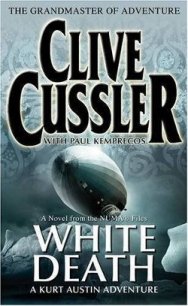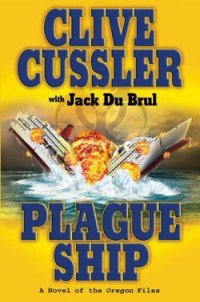Corsair - Cussler Clive (полная версия книги TXT) 📗
And then there was Mark and his partner in crime, Eric Stone. Eric’s room was a geek’s fantasy, with every conceivable video-game console and controller. The walls were adorned with pinup girls and gaming posters. The floor was a static-dampening rubber that was crisscrossed with a couple thousand feet of cables. His bed was an unmade pile of sheets and blankets tucked into one corner.
Mark had gone for a minimalist vibe. The walls of his cabin were painted a matte gray, with a matching carpet. One wall was a video display system nearly eighteen feet across and composed of dozens of individual flat screens. There were two overstuffed leather chairs, a queen-sized bed, and a stark chest of drawers. The room’s dominant feature was the speakers. The four of them stood seven feet tall and resembled Frank Gehry’s Guggenheim Museum in Bilbao, Spain. Murph claimed that sharp angles in a speaker system affected the sound. Considering the garbage he listened to, Juan wasn’t sure how his young weapons specialist could tell.
Murph and Stone were standing in front of the video display, looking at satellite imagery provided by Langston Overholt. With the Oregon driving hard for Libya, Cabrillo had finalized a contract with Lang to act as a covert search-and-rescue group and had gotten his people thinking about what they would find once they reached their destination. He had also asked for the raw satellite imagery that he was certain the National Reconnaissance Office had obtained within a few hours of Secretary Katamora’s disappearance.
Mark and Eric had altered some basic pattern-recognition software to help them search the imagery for a downed aircraft. The NRO had a dedicated staff of dozens doing the same thing, with hardware and software more sophisticated than what was at his people’s disposal, but Juan was confident they would find the downed 737 first.
Juan flipped the light switch to get their attention.
Murph pointed a remote at the stereo rack and muted the system.
“Thank you,” Juan said. “Just so I don’t buy the CD by mistake, who was that?”
“The Puking Muses,” Mark replied as though Cabrillo should have known.
“Yeah, no way I’d make that mistake.”
Mark was wearing ripped jeans, and a shirt that said PEDRO FOR PRESIDENT. His hair was a tangled dark mane, and to Juan’s surprise he had shaved off the scraggly whiskers he called a beard. Eric was in his customary button-down shirt and chinos.
Cabrillo touched his chin and said, “About time you got rid of the dead bird on your face.”
“This girl I’m chatting up on the net said I’d look better without it.” Mark’s cockiness had returned following the Chairman’s rebuke over his mistake in Somalia. Sam Pryor, the wounded engineer, said he harbored no ill feelings but was going to make Murph his personal valet once he got out of Medical.
“Smart woman. Marry her. So what have you got so far? Wait. Before you answer, what is that?”
He pointed to the map on the screen where the Sahara desert met the Mediterranean, about fifty miles west of the recognizable urban sprawl of Tripoli and its suburbs. Where the coastline usually ran in a fairly even stroke, there was an area where the sea pushed inland in a perfectly shaped rectangle. It was obviously a man-made feature, and, from the scale on the monitors, enormous.
“A new kind of tidal power station,” Eric said. “Just came online a month ago.”
“I didn’t think the Med has high enough tides,” Juan mused.
“It doesn’t, but this power station doesn’t rely on the ebb and flow of the tides. The place they built the plant had been a narrow-mouthed bay that was much deeper than normal for the region. They built a seawall across its mouth and pumped it dry. They then expanded the dried-out bay so it was wider and deeper than it was originally. There is a series of sluice gates running along the seawall near its summit and sloping downward. During high tide, water pours through the gates, down pipes, and turns turbines to produce electricity.”
“That doesn’t make any sense. Eventually, the old bay will fill with water. I don’t care how big they made it.”
“You’re forgetting the location.” Eric had a little smirk on his face. When he’d first read about the project, he had intuitively grasped the facility’s secret. When Juan stared back blankly, he added, “The desert.”
The Chairman suddenly understood. “Evaporation. Brilliant.”
“The reservoir had to be wide and broad but not necessarily deep. They calculated typical evaporation rates to get the right size for the amount of electricity they wanted to produce. By the time the sun goes down in the evening, the artificial lake is virtually empty. Then the tide rises, water pours in through the powerhouse, and the cycle is repeated.”
“What about the . . .”
“Excess salt? It’s trucked away at night, and sold to European municipalities as a deicing agent for roads. Completely renewable, clean energy, with the bonus of a few million dollars a year in road salt.”
“There is a potential problem,” Mark said, “Over time, the excess evaporation could change weather patterns downwind from the site.”
“The report I read said it would be negligible,” Eric said, defending the project from Mark’s natural paranoia.
“That report was written by the Italian company that developed the plant in the first place. Of course, they’re going to say it’s negligible, but they don’t really know.”
“Not our problem,” Cabrillo said before Mark could ramp up one of his conspiracy theories. “Finding the Secretary’s plane is. What have you got so far?”
Murph chugged half a can of Red Bull before answering. “Okay, we’ve got a couple of scenarios. Number one is the plane exploded in midair, either the result of a catastrophic failure, like TWA 800 over Long Island south shore, or a missile strike, also like TWA 800, depending on who you believe. If that’s the case, then we would have wreckage strewn over a hundred square miles when we factor in the plane’s speed and altitude.”
“It would be nearly impossible to spot any of it without knowing approximately where the event occurred,” Eric said, wiping his glasses on the tail of his shirt.
“We know when their transponder and communications died,” Mark pointed out. “A quick extrapolation of their course, speed, and estimated time of arrival at Tripoli International would have put the event just on Tunisia’s side of the border with the wreckage landing on Libya’s.”
“Is that what you have there?” Juan asked, pointing to the desert imagery on the multipanel display.
Murph shook his shaggy head. “No, we already checked it out, and nada. We saw an abandoned truck and a lot of tire tracks left by what we assume are border patrols, but no plane.”
“That’s good news, then,” Juan said. “Her aircraft didn’t suffer a midair explosion.”
“Good and bad,” Eric replied. “Since we don’t know the nature of the event, it becomes much more difficult to figure out. Did the oxygen system fail and kill the crew, so the plane just kept flying until it ran out of fuel? If that’s the case, it could have struck five hundred miles or more to the east of Tripoli, possibly even in the Med. Or there could have been an engine failure. If that happened, the plane would have glided for miles before impact.”
“But that wouldn’t explain the radio silence,” the Chairman pointed out. “The crew would have radioed an emergency.”
“We know that,” Mark said a little defensively. “Still, we have to investigate every possible theory to winnow—good word, eh?—to winnow down our target area. It’s unlikely the radios would die the same moment as the engines, but stranger things have happened. Hey, that reminds me, have the feds talked to the ground people who serviced that plane last? You know, it could have been sabotaged.”
“Lang said the FBI is conducting interviews as we speak.”




